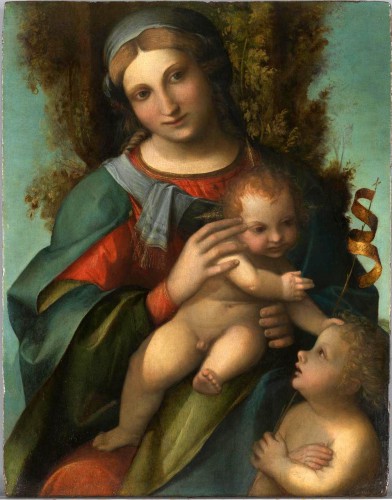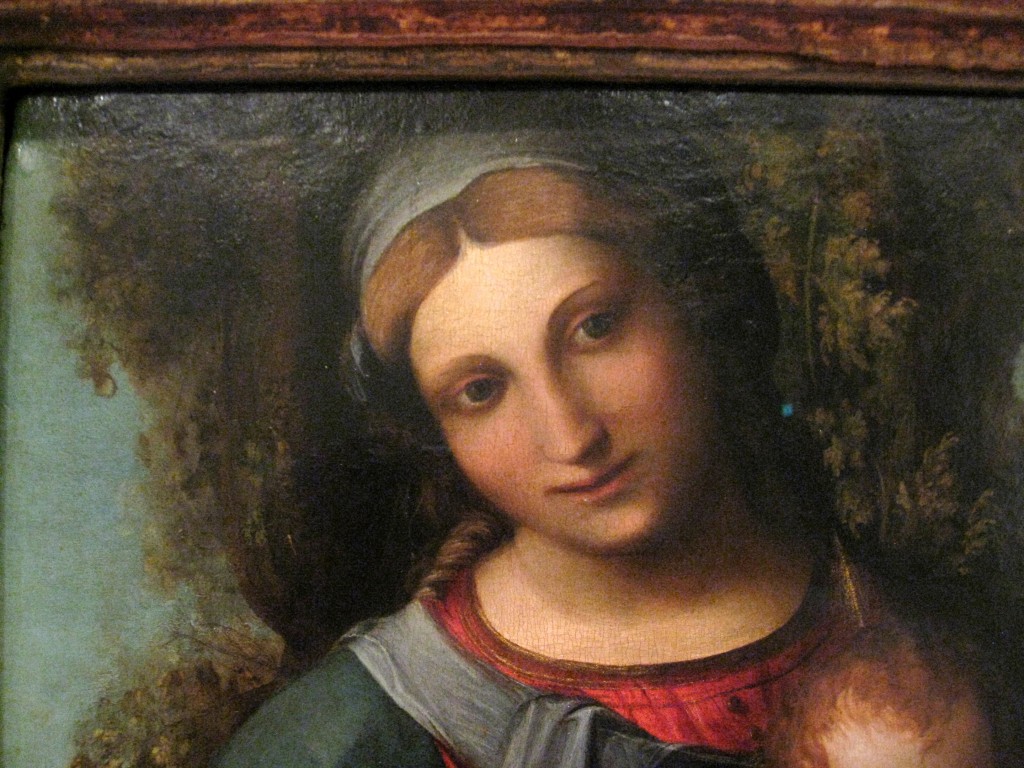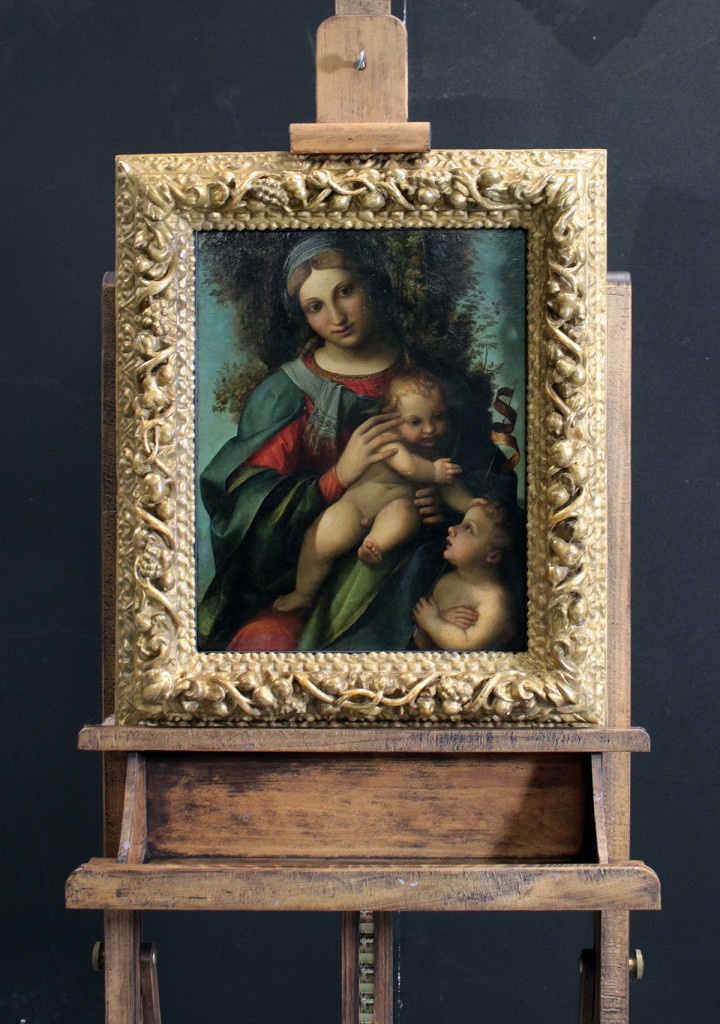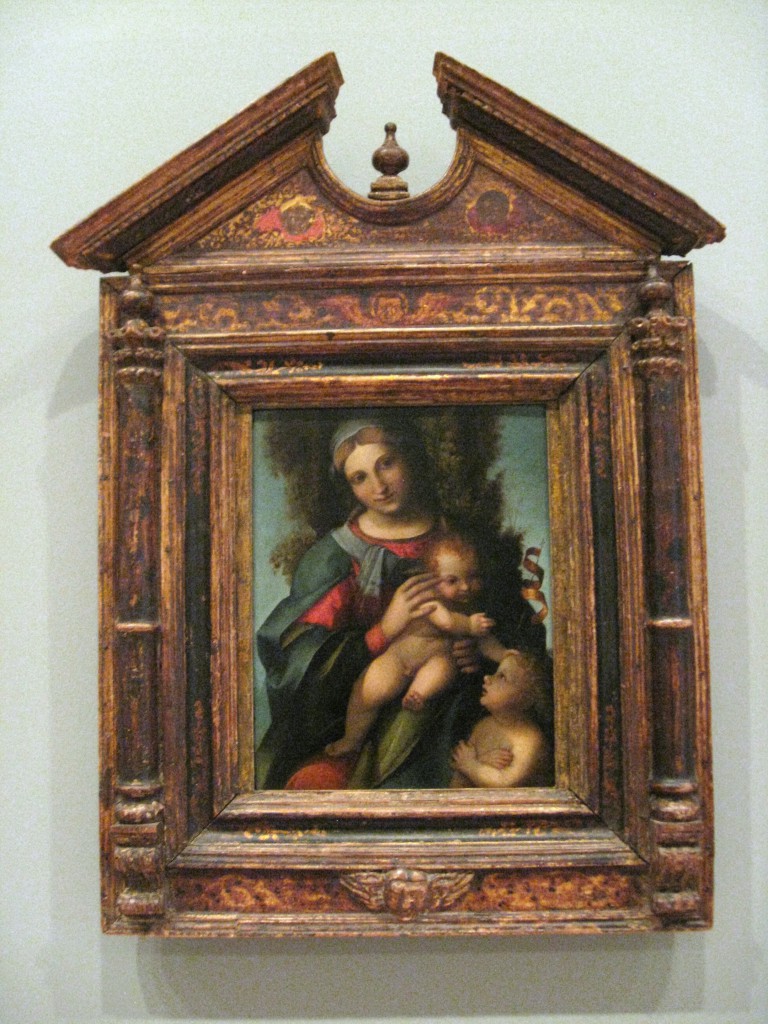Walking through the National Gallery of Victoria’s rooms displaying fifteenth-to-sixteenth-century European art recently, I was pleased to see the Gallery’s 2011 purchase of the painting by Correggio (Antonio Allegri, 1489–1534), ‘Madonna and Child with Infant John the Baptist’ (1514-1515), included in the ‘hang’. At the time of purchase the painting was identified as a valuable work of art with qualities that can be defined as essentially High Renaissance: clarity, simplicity, sensitive use of colour, light and shadow, and technical brilliance.
As an Italian painter from the north, Correggio was influenced by the ‘classical’ Raphael and Michelangelo as well as, primarily, the treatment of light and soft modelling (sfumato) by Leonardo da Vinci. Correggio’s naturalistic handling of subject matter can be seen in his subtle use of colour, particularly in the flesh tones. The intimate, tender expression of Correggio’s Madonna and Child in this featured painting contrasts with the linear, sculptural style of the Francia painting of the Madonna and Child (circa 1515) hanging nearby (see detail below). Correggio eventually moved from his hometown, Correggio (he was obviously named after the town of his birth), to nearby Parma and undertook his great illusionistic dome paintings, which were emulated by later Baroque painters.
Franco Francia, Giacomo Francia, Giulio Francia, ‘Virgin and Child with the young Saint John in a garden of roses ‘(Detail), c. 1515, oil on wood panel, NGV, Melbourne
Melbourne art historian David R. Marshall’s initial response when he first viewed the Correggio painting following its purchase by the NGV in 2011 was pure delight. He was convinced that the painting had the qualities that relate to Correggio’s early style and technique: “gradually the subtleties of Correggio’s hand emerged”. He wrote:
The head of the Baptist then emerged as having a degree of intimately observed naturalism that distinguishes Correggio’s work: Correggio loved children and women. This naturally led to a study of the Madonna’s face, which was disappointingly schematic, the besetting sin of Renaissance Madonnas: a bit of Leonardo in the mouth, a bit abstract in the eyebrows and eyelids. Yet the eyes themselves seemed to be alive. Cruising back over it again and again, the quality and condition began to emerge more and more strongly. Too many paintings don’t quite make it in these departments and this kept looking better and better.
This close visual analysis by a Renaissance and Baroque painting expert can be relied upon to identify the authentic style and technique of Correggio, but examination by the NGV’s skilled conservation team revealed materials specifically used in the Renaissance and qualities seen in other early Correggio paintings. Even though it was in remarkably good condition at the time of purchase, considering it is 500 years old, conservation treatment has not compromised the value, instead, the cleaning process has enhanced its qualities. NGV paintings conservator, Carl Villis, removed darkening varnish with care to ensure that the original aesthetic, and Correggio’s colour harmony was restored. Apparently there was some over-painting that probably dated from the nineteenth century, and a few golden curls were removed, which were thought to have been added to Christ’s hair at the same time as the over-painting.
The support used in the Correggio painting is poplar wood panel, which verifies support preference in the Renaissance, but the hand-carved and gilded wood frame encasing the painting when it was purchased was possibly a nineteenth-century addition. Fortunately this frame has been replaced during conservation by an appropriate Renaissance tabernacle frame, which reconnects with its possible original context as a private devotional work.
Many factors contribute to the debate as to how one determines the value of a work of art, whether it is centuries-old or more recently created. Foremost, authenticity needs to be identified, and technological examination assists with the dating of art by confirming raw materials used during different historical periods. Valuable materials will ascribe monetary value to the work of art, but the personal, social and cultural value embodied in the work, as well as the identification of an artist’s ‘hand’ or signature style and technique, are the qualities that determine authenticity and value.
Rarity and the condition of the work are additional factors considered when establishing value, but ultimately the meaning or mood imbued in the work through artistic expression adds an intangible quality which cannot be measured in monetary terms. Correggio’s ‘Madonna and Child with Infant John the Baptist’, at £3,625,250/$5.2 AUD (including buyer’s premium), was the second-most-expensive picture in the Sotheby’s July 2011 sale—not cheap, but value-for-money for a significant early work by such an important artist of the High Renaissance, who was a forerunner of the Baroque.
Featured painting: Correggio (Antonio Allegri), Madonna and Child with Infant John the Baptist, 1514-15, oil on poplar wood panel, 45.0 x 35.5 cm, NGV, Melbourne (acquired for the Gallery by NGV Trustee Andrew Sisson, 2011).

